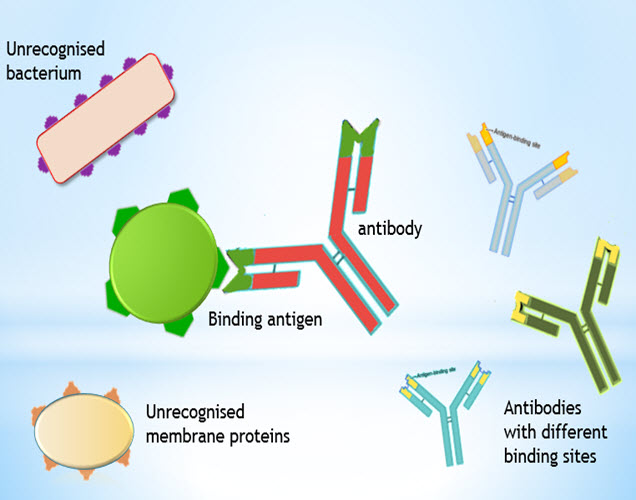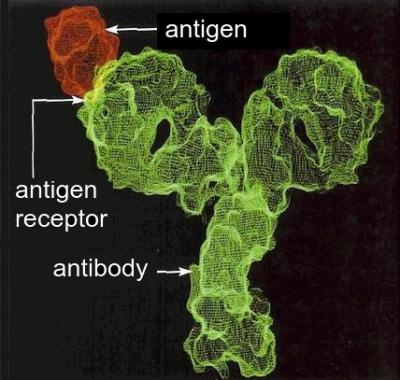Antigens and antibodies
 A few simple slides help to introduce the basic concepts in this lesson. This is followed by an activity to describe the immune response to an infection of bacteria into a small cut on a student's finger. A final activity asks students to describe the role of the skin as a barrier to infection and to consider how mucus membranes help to protect the body's most vulnerable areas.
A few simple slides help to introduce the basic concepts in this lesson. This is followed by an activity to describe the immune response to an infection of bacteria into a small cut on a student's finger. A final activity asks students to describe the role of the skin as a barrier to infection and to consider how mucus membranes help to protect the body's most vulnerable areas.Lesson Description
Guiding Question
How can the proteins on the surface of cells, called antigens, help the body's immune system to identify pathogens?
Activity 1 - Distinguish between antigens and antibodies
Use the following slides to introduce antigens and antibodies ![]() Antigens & antibodies
Antigens & antibodies
Questions
- What is an antigen?
An antigen is a chemical which stimulates the production of an antibody when it is inside the body. Usually proteins, antigens are found on the surface of cells.
- Which type of cells have antigens on their surface?
All cells have antigens on their surface. Eukaryote and prokaryote cells.
The human body does not normally produce antibodies to its own cells. - How many different types of lymphocyte are there?
There is a very large variety of lymphocytes.
- How many different types of antibody can one type of lymphocyte produce?
Each type of lymphocyte can only produce one type of antibody.
- What is an antibody made out of?
Antibodies are made of protein. They all have a Y shaped structure but the antibody binding site is different in different antibodies.
Activity 2 - Explain the process of antibody production
Complete the storyboard activity on the ![]() lymphocyte activity sheet below by adding answers to the questions next to each image.
lymphocyte activity sheet below by adding answers to the questions next to each image.
This activity could be a "Broken Pieces" group task as an alternative, see the teacher's notes below.
Activity 3 - Plenary activity
Complete one of the plenary activities below or the risk taking alternative in the teachers' notes.
![]()
Teachers notes
This lesson is all about lymphocytes and antibodies.
Activity 1 has a short powerpoint of diagrams which can be used to explain the features of antigens and antibodies and the idea that there are many types of lymphocytes which each produce one antibody.
An alternative would be to have students research information to explain each of the slides.
The five short questions which follow the slides include model answers and help to focus on the main points of the topic.
Activity 2 is a worksheet activity which requires students to use their learning in a specific example of the immune response.
An alternative way to run this activity
- Arrange students into groups of six.
- Cut the table from the worksheet into six rows and randomly give one row to each student in the group.
- STUDENTS MUST NOT SHOW THEIR PAPERS TO OTHERS
- The student who has the finger image - is the scribe their job is to write a full explanation in a logical order.
- The other five students explain answers to each of their images in turn (but not necessarily in the order of the sheet.)
- It is the groups' responsibility to decide the correct order of explanations and to discuss and debate this as they give instructions to the scribe.
- Once the whole process has been described students can assemble their six pieces and make individual notes / take a photocopy / photograph.
Activity 3 is a nice final activity for students who finish early. If students have access to phones, tablets or computers they could do this activity as a real text message to a parent, a Google+ share, a tweet in twitter, or a Facebook status update.
Risk-taking alternative plenary activity
It is possible for students to role play the production of antibodies in response to antigens in a small play with simple props.
First ask the students to decide how many characters there needs to be in the 'play' and how many props.
Then decide what to use as props, and who will take each role. If the class is large then there could be a narrator, or understudies who learn the lines of a character.
Decide upon a short script, and narration for each step of the process, and where each of the characters will be in the lab.
Nominating a student as a director may help, and a photographer could be added if there is any student not wanting to participate. Be sure to run throgh the play a couple of times so that students can remember their role.
A model answer to a past paper question could be a good starting poing for the script of the play.

 IB Docs (2) Team
IB Docs (2) Team
